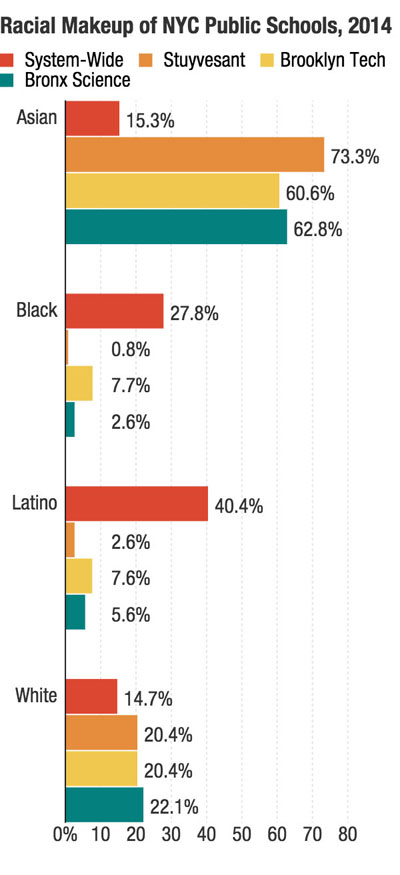Proposals to Diversify NYC’s Top High Schools Would Do Little to Help, Study Finds
Gene Demby, NPR, April 3, 2015
New York City’s public school system is vast, with more than a million students spread across thousands of schools. And like the city itself, it’s remarkably diverse–about 15 percent Asian, just under 30 percent black, about 40 percent Latino, and about 15 percent white, with all sorts of finer shadings of ethnicity, nationality and language in that mix.
The city also boasts nine elite “specialized” public high schools–of which the Bronx High School of Science, Brooklyn Technical High School, and Stuyvesant High School are the most difficult to get into. They’re largely considered the school system’s crown jewels, regularly sending students to top-tier universities. The demographics at those schools look a lot different.
{snip}
The conversation about how to boost the number of black and Latino kids at those three schools tends to focus on their narrow admissions process. There are no interviews, no applications, no required transcripts; whether a student gets in depends entirely on how she does on a 2 1/2-hour multiple choice exam called the Specialized High School Admissions Test.
Critics say that all-or-nothing emphasis on the SHSAT exam hurts otherwise academically talented black and Latino kids who might otherwise get in. {snip}
{snip}
But a report released last month by New York University found that many of the proposals that advocates have suggested to help bolster black and Latino enrollment at those schools wouldn’t make much of a dent–indeed, the researchers found that they might do the opposite.
“Maybe it was naive, but I thought if you switched to more holistic measures, it would diversify the admissions pool considerably,” said Sean Corcoran, one of the researchers, told Sarah Danville of GothamSchools. But the study found that there is “considerable overlap in students who would be admitted under different rules.”
The researchers wrote that using an alternative admissions criteria–taking some combination of grades, state test results and attendance into account–would “have little effect on the average baseline achievement of specialized high school students . . . but would have large effects on their demographics.”
They found that under the broader criteria, many more girls would be admitted to the specialized schools–at Stuyvesant this year the gender gap is close to 600 students–and more white and Latino students would get offers to attend those schools, and fewer Asian kids would be admitted. But they found that the new criteria would do little to boost the numbers of black kids, and in some cases actually might lower them.
The NYU researchers said that guaranteeing entry to the top students from every high school would make the elite high schools more diverse, but warned that taking that approach would come “at the cost of reducing the average achievement of incoming students.”
{snip}
The acceptance letters for the upcoming fall school year went out across New York City in March. There were 953 spots in the freshman class at Stuyvesant for fall 2015, the most competitive of the specialized schools. Only 10 black students managed to get in.
















